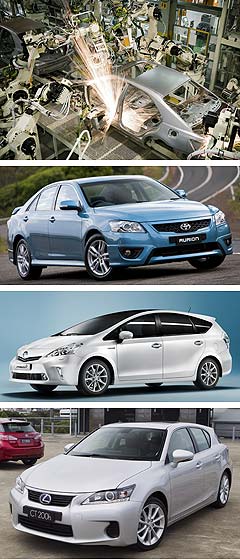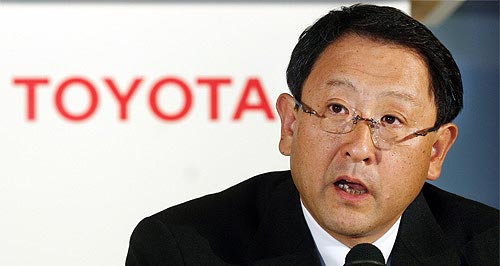Make / Model Search
News - ToyotaToyota creates new ‘global vision’Global vision: Akio Toyoda’s vision centres on North America and emerging markets, but Toyota Australia believes the restructure should only benefit its local operations. No threat to Aus operations as Toyota sets out new mid-term business plan10 Mar 2011 By TERRY MARTIN TOYOTA Motor Corporation (TMC) has announced it will make the United States its global centre for Camry development, production and export as part of a new mid-term business plan that includes doubling its operating profit, launching 10 new hybrids and selling nine million Toyota and Lexus vehicles a year by 2015. The so-called ‘Toyota Global Vision’ announced overnight outlines the Japanese auto giant’s comeback strategy following the global financial crisis and a string of damaging product recalls. It foreshadows new attempts by the company to increase sales in emerging markets and place them on an even keel with industrialised nations – up from the current 60:40 per cent balance – as well as a massive senior management restructure that will come into effect in the coming weeks. The latter will see the elimination of vice-chairman positions and cut TMC’s board from 27 to 11 members, with former president and CEO Katsuaki Watanabe and North American chief Yoshi Inaba among the casualties. Mr Inaba retains his responsibilities in the US, and although TMC president Akio Toyoda has removed him from the board – and said in a press conference last night that it would be “premature” to contemplate non-Japanese or external board members – Toyota has bolstered its all-important North American operations, which account for some 60 per cent of its operating profit, excluding exports. One of the architects of the plan is understood to be president of Toyota’s Canadian operations, Ray Tanguay, who will move to a newly created position of senior managing officer on April 1 and become TMC’s highest non-Japanese executive.  From top: Camry Hybrid under production at Altona plant, Aurion Sportivo, Prius+ from Geneva 2011, Lexus CT200h. From top: Camry Hybrid under production at Altona plant, Aurion Sportivo, Prius+ from Geneva 2011, Lexus CT200h.In announcing the blueprint, Mr Toyoda said: “For the Camry and other vehicle series, we plan for North America to become a global centre responsible for R&D and production, as well as exports. “We would like to make sure that Camry is really regarded by American consumers as truly their own car – the national brand car of America – and we intend to make even further efforts so that Camry can continue to earn that strong support and encouragement from American customers. “I also want to reinforce our work on future mobility through collaboration with North American leaders in information technology, and other leading-edge fields. Our successful alliance with Tesla Motors is a good example of the potential benefits of collaboration.” Toyota Motor Corporation Australia (TMCA) media and communications manager, Laura Hill, told GoAuto that TMC’s increased emphasis on Camry in the US, including with exports, should not pose a threat to its Australian operations. “While the US has been identified as the global centre for Camry production, it doesn’t mean all the vehicles will be produced there as each Toyota plant has its own advantages,” she said. “In TMCA’s case, the successful local production of Camry, V6 Aurion and Hybrid Camry was a key factor in securing a further $300 million investment to build the next-generation four-cylinder Camry and Hybrid Camry engines at our Altona plant in Melbourne. “TMC always looks for the best sourcing options when supplying export markets. Australia is still the strategic supplier of Camry and V6 Aurion to the Middle East. “Also, the Camry model produced in the US is different to the model TMCA produces,” she said, adding that the Aurion is also not currently built for the North American market. Toyota’s Australian manufacturing operations are underpinned by Camry, with more than 95,000 units of the medium-sized sedan produced at Altona last year – more than 70,000 of which were exported to more than 20 countries, mostly in the Middle East. Camry is also the biggest-selling car in the US, having topped the sales charts for 13 of the past 14 years, including the past nine years in a row. Last year, Toyota sold just over 327,800 Camrys in the US. Apart from Altona, Camry is produced in seven other plants, including two in the US, and one in Japan, Thailand, China, Russia and Vietnam. In outlining the new plan, Mr Toyoda said the company had set a target of securing 15 per cent of its global sales in China, “and we are working to achieve that target as soon as possible”. He said Toyota’s main focus in Oceania was on emerging markets, which will be supplied with vehicles “tailored to local needs” – such as those built from its ‘Innovative International Multipurpose Vehicle’ platform. “We hope our operations in these countries will grow into global bases of lean and efficient R&D and production ramp-ups,” he said. Ramifications for Australia are still to become apparent, although from a management level more responsibility will be handed to the Asia-Pacific division to “decide on how best to serve their customers”. TMC said regional operations will begin drawing up plans in April that will “define their roles to play and issues to address in support of fulfilling the Toyota Global Vision and that will detail their regional mission and management strategies”. Ms Hill said the new management structure would bring a number of benefits to Australia. “Affiliates like TMCA used to report to Japan through multiple layers of management,” she said. “This had the potential to slow decision making and affect our ability to promptly relay to management customer feedback and other information from the field. “Under yesterday’s changes, TMCA will now report directly to Toyota Motor Asia Pacific in Singapore and Bangkok. The new communications channel has fewer layers, allowing TMCA’s voice to be delivered to TMC faster. It will also set up the process to enable increased decision making by TMCA. “As part of the new structure, TMC will delegate more authority to regional operations to better tailor vehicles to local markets. “For Australia this means TMCA will have more authority in designing, styling and manufacturing vehicles,” she said, adding that there should be more flexibility to tap into the capability of the Australian-based Toyota Technical Centre Asia-Pacific and Toyota Style Australia. “This will result in TMCA being more responsive to customer feedback. It is expected the new structure will also help shorten the lead time required to implement design changes at the production level.” By 2015, TMC expects to increase sales of Toyota and Lexus vehicles from 7.53 million expected in the current financial year (ending March 31, 2011) to nine million – Daihatsu and Hino models were specifically excluded from the plan, although Mr Toyoda later conceded they would add another million units or so – and achieve an operating profit of ¥1 trillion ($A11.95 billion), based on current sales volume and an exchange rate of ¥85 to the US dollar. This compares with a target of ¥550 billion operating profit forecast for the current fiscal year, but is well below the record ¥2.27 trillion TMC achieved in 2007. Lexus is considered a key part of Toyota’s return to strength. A Lexus Group has been established under the restructure to bolster product and marketing planning for the luxury division, but buried deep within official TMC documents is the disclosure that Toyota has also eliminated its Lexus Development Centre, which was part of its product development group. Toyota Australia has been unable to clarify what this means for Lexus going forward. The other important aspect to the ‘global vision’ program is the continued rollout of environmentally friendly models, including a full hybrid line-up for Lexus. “Our product strategy in the years to 2015 will centre on models for minimising environmental impact and on models optimised for needs in emerging markets,” Mr Toyoda said. “We will expand our line of hybrid models, launching about 10 more by 2015. And we will continue to develop a full range of plug-in hybrid vehicles, pure electric vehicles, and fuel cell vehicles.” In response to a question on TMC’s new emphasis on globalisation, Mr Toyoda said: “Have we changed the recognition of Toyota being a Japanese company? This remains unchanged. “No matter how Toyota is evaluated as a global company, we still have the role of a company that represents the Japanese economy.”  Read more10th of March 2011  Toyota urges feds to tread carefully on carbonMore detail needed before car industry can support carbon tax, says Toyota25th of February 2011  Another 2.2 million Toyota and Lexus vehicles recalledFloor-mat concerns prompt another round of US Toyota safety recalls19th of October 2010  Toyota Camry locked and loaded for 2011Standard Camry to lead new model roll-out next year, with hybrid to follow in 2012 |
Click to shareToyota articlesResearch Toyota Motor industry news |











Facebook Twitter Instagram